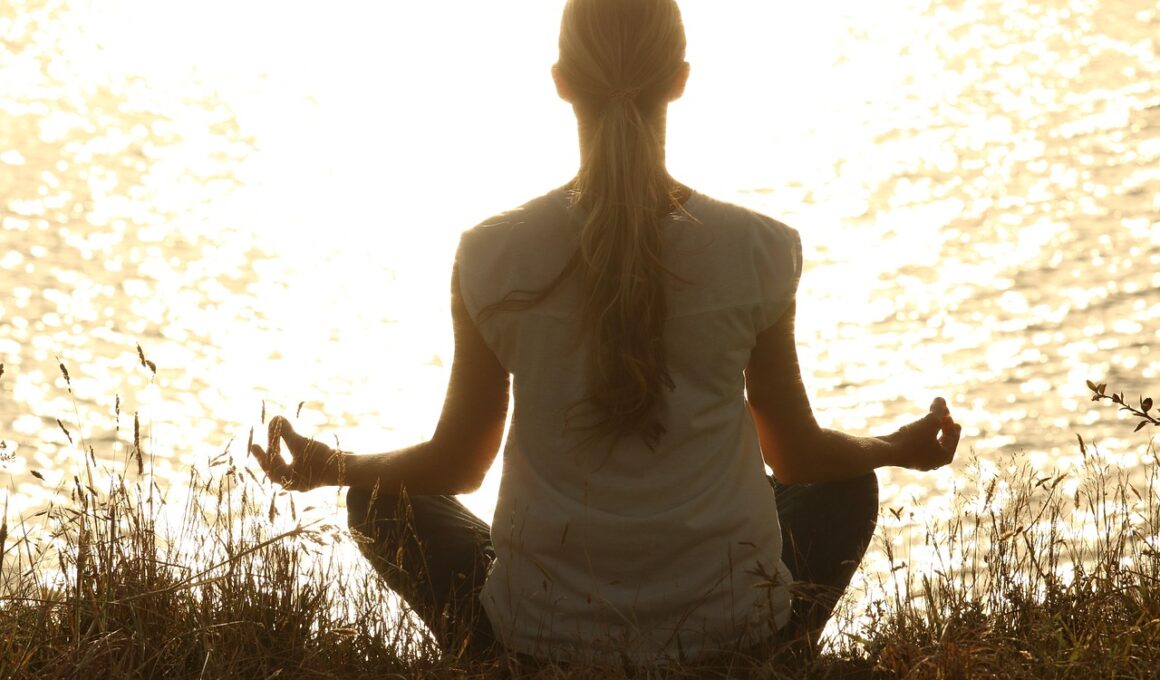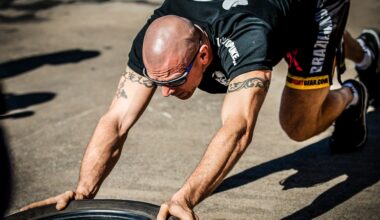How Meditation Improves Balance and Precision in Sports
Meditation has been celebrated for its myriad benefits, which extend beyond mental clarity to enhance physical performance in sports. Athletes are integrating mindfulness techniques into their training regimens, particularly focusing on achieving a higher level of balance and coordination. This practice involves maintaining a focused state, allowing athletes to connect deeply with their body movements. Through meditation, individuals can better understand their proprioception, which is their awareness of body position in space. Furthermore, meditation reduces distractions that may interfere with performance. For sports requiring precision, such as gymnastics or archery, the ability to maintain focus can be the key to success. Athletes who meditate regularly often report an increase in their ability to react and move in a fluid manner during competition. This improved coordination not only enhances performance but also minimizes the risk of injury. Meditation teaches the athlete how to breathe properly, which is essential for controlling heart rate and exertion levels. Consequently, integrating meditation into training can lead to profound improvements in athletic performance, particularly in balance and precision-focused sports. In short, this ancient practice holds valuable lessons for modern athletes.
One of the core components of meditation is its ability to promote concentration, which is vital for balance and coordination. Focused attention meditation trains the mind to minimize distractions, enhancing an athlete’s consistency in their performance. When the mind is quiet and focused, the body follows suit, allowing for more precise movements. With improved mental clarity, athletes can analyze their movements more critically and make necessary adjustments. This informed awareness transforms how they execute skills in their sport, from precise foot placement to coordinated limb movement. The process of meditation encourages a slower and more mindful approach to training. By becoming acutely aware of the mechanics of their movements, athletes can recognize areas that require improvement. Meditation also helps in developing a mental image of perfect execution, thereby influencing muscle memory positively. Visualizing successful performance through meditation contributes to an athlete’s confidence, enabling them to replicate these successful movements during competition. Therefore, the integration of meditation techniques not only enhances performance but reinforces a strong mental state required for facing the pressures of competitive sports.
Meditation Techniques for Athletes
Different meditation techniques can be applied to enhance balance and coordination. Mindfulness meditation is particularly effective for athletes, as it involves observing one’s thoughts and feelings without judgment, fostering a non-reactive awareness of bodily sensations. This kind of awareness allows athletes to stay grounded and better in tune with their body’s balance during dynamic movements. Breath-focused meditation is another relevant technique, where athletes concentrate on their breathing patterns. This practice promotes relaxation and helps maintain the heart rate, enhancing performance capabilities. Visualization techniques also come into play; athletes can visualize their movements, enabling their bodies to execute the maneuvers more effortlessly. Combining these techniques can create a comprehensive practice that nurtures both ease of movement and mental clarity. By practicing these meditation styles regularly, athletes develop greater focus and coordination. The mental benefits translate into physical ones, as they become more adept at making split-second decisions during their games. Meditation encourages athletes to find a calm inner space from which they can launch the intense physical efforts required in sports. This harmony is key for achieving peak performance.
Research supports the positive impacts of meditation on physical performance. Studies show that athletes practicing meditation exhibit improved reaction times, stability, and overall precision. A study indicated that those who meditated consistently displayed increased levels of focus and reduced anxiety, which are crucial factors during competitions. When athletes can control their mental state, they effectively regulate their physical responses, leading to improved coordination. As meditation enhances both mental and emotional stability, athletes can handle the pressures of competition with greater ease. Successful competitors often cite mental clarity as a critical element of their performance, attributing their success to disciplined meditation routines. The self-awareness cultivated through meditation leads to a deeper understanding of one’s physical limits and capabilities. Athletes who regularly meditate become more responsive to their body’s signals, which is essential for making critical performance adjustments and enhancing balance. This improvement is particularly noticeable in sports requiring fine motor skills, such as tennis or fencing. Consequently, meditation emerges as a vital component in an athlete’s toolkit for achieving excellence and maintaining competitive edge in their respective sports.
Improving Mind-Body Connection
Enhancing the mind-body connection through meditation serves a foundational role in improving balance and coordination for athletes. Meditation fosters a deeper relationship between an athlete’s mind and body, allowing them to execute movements more fluidly and with increased precision. When athletes meditate, they cultivate body awareness, enabling them to feel tension, relaxation, and balance more profoundly during their activities. This heightened awareness leads to better control over their bodies in dynamic situations, which is crucial for success in competitive sports. Moreover, a stronger mind-body connection helps athletes respond instinctively to their environment, enhancing their agility and coordination. Mindful movement practices, such as yoga or tai chi, can complement meditation, providing a holistic approach to physical training. By focusing on controlled, deliberate movements in these practices, athletes learn to integrate mindset with physicality. This encourages a seamless performance flow during competition. Athletes who engage in both mindful practices and meditation report experiencing a sense of harmony within their bodies, which naturally translates into improved performance. Thus, fostering the mind-body connection is instrumental for achieving better balance and coordination in sports, leading to lasting success.
Another significant benefit of meditation lies in its ability to enhance recovery. Athletes often face rigorous training schedules that can lead to fatigue and stress. Meditation provides an effective strategy for inducing relaxation and calming the nervous system, allowing for better recovery between training sessions and competitions. Enhanced recovery is crucial for maintaining optimal performance levels while reducing injury risk. Athletes who meditate regularly often report improved sleep quality, further supporting recovery and overall athletic performance. The reduction of stress through meditation also has a direct effect on physical health. It can lower cortisol levels, which when elevated can lead to detrimental effects on athletic performance. Additionally, meditation fosters resilience: athletes equipped with strategies to manage stress are less likely to succumb to performance anxiety during critical moments. This resilience is indispensable in sports, where mental composure can determine outcomes. The combination of improved recovery and stress management through meditation ultimately leads to sustained performance improvements. This results in athletes achieving their personal bests, contributing to long-term athletic success and personal fulfillment in their sporting journey.
Conclusion
In conclusion, meditation serves as a progressive tool for enhancing balance and coordination among athletes. Its multifaceted benefits—including improved focus, a strong mind-body connection, and enhanced recovery—make it an indispensable part of sports training. Athletes are increasingly recognizing the importance of mental training alongside physical preparation to achieve peak performance. As meditation continues to gain acceptance in the sports community, it is evident that the connection between mind and body plays a critical role in athletic success. With mindfulness practices steadily weaving into training regimens, athletes can innovate their approach to achieving greatness. The ability to maintain calm under pressure while achieving enhanced coordination can redefine the competitive landscape. As more athletes explore meditation, we observe inspiring transformations in their performance and overall well-being. Sport has long been seen solely as a physical endeavor; however, the revelation of mental performance techniques brings a new dimension to athletic excellence. Meditation provides the pathway to mastering both body and mind, ultimately leading to a more fulfilling and successful sports career.
Therefore, exploring meditation is not just an optional enhancement; it is essential for the contemporary athlete striving for balance and precision. As research highlights the tangible benefits of mindfulness, practitioners find newfound dedication to incorporating these practices into their daily routines. Athletes who understand the value of mindfulness can cultivate an edge over their competitors, leveraging meditation for improved performance in today’s high-stakes sports environment. Embracing meditation invites athletes to deepen their self-awareness, transform their approach to training, and thrive in competitive situations. The importance of integrating mental training cannot be overstated; it assures that athletes maintain their focus even amid the fiercest competition. Ultimately, meditation emerges as a powerful ally for athletes; it cultivates a competitive edge while enhancing overall well-being. The road to success in sports is paved with both physical conditioning and mental acuity. Having a comprehensive strategy that balances both dimensions prepares athletes for challenges they face on their journey towards excellence. Those willing to commit to this practice can expect to observe marked differences in their balance, coordination, and overall athletic performance.


